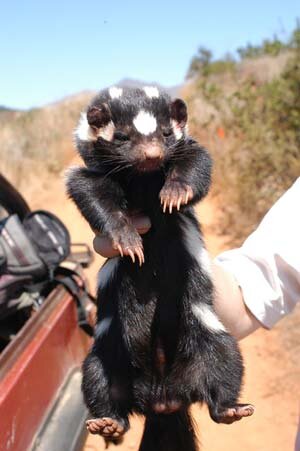Island Spotted Skunk
Spilogale gracilis amphiala
Santa Rosa Island
Status and Demographics of the Santa Rosa Island Spotted Skunk
John E. DePue, David K. Garcelon, and Timothy J. Coonan
Introduction
The island spotted skunk is an insular subspecies of the western spotted skunk, endemic to only two of the California Channel Islands; Santa Rosa and Santa Cruz islands. The recent decline of the endemic island fox (Urocyon littoralis) on the northern Channel Islands prompted our investigation on the status of the island spotted skunk on Santa Rosa Island. Little is known about the island spotted skunk on Santa Cruz Island, and no data have been collected on the status of the Santa Rosa Island population. Our objectives were to collect data on the distribution, demographics and relative abundance of the island spotted skunk.
Study Area & Methods
Santa Rosa Island (34°N, 120°W) is located 24 km west of Ventura, California. The island (21,118 hectares) consists of hills and steep canyons covered by grasses, chaparral, coastal sage, and scrub oak.
Trapping consisted of placing 7”x7”x24” and 9”x9”x26” box traps along transects in canyon bottoms, along streambeds and on ridge tops across the island. Traps were baited with both dry and canned cat food as well as a fruit paste. Captured skunks were anesthetized with an intramuscular injection of ketamine hydrochloride and acepromazine. Animals were sexed, aged, weighed, a blood sample taken, and each animal was marked with PIT or ear tags. Skunks were anesthetized for 30–40 minutes, returned to trap and released.
Results
During 371 trap nights we captured 83 individuals 104 times, yielding a trap success of 28%. Skunks were captured in 42 (n = 136) different trap locations and were captured in all areas of the island where trapping was conducted. The sex ratio was highly skewed toward males 3.4:1, which differed significantly from 1:1 (P = 0.016). The mean weight of female skunks 418 g (n = 18, SE = 12 g) was considerably less than that of males 627 g. (n = 61, SE = 12 g).
Discussion
While females were considerably smaller than males, we had no evidence that females were failing to set off traps, and we had only one case of a skunk escaping from a trap. Female skunks may avoid traps more often than males, or males may comprise a larger proportion of the wild population. The sex ratio of skunks on Santa Rosa Island was considerably different from the 1:1 sex ratio found on Santa Cruz Island (Crooks 1994), although the sample size of captures was much lower in that study (n = 10). The overall trap success of 28% is significantly higher then the 0.6% trap success reported by Crooks (1994) for island spotted skunks on Santa Cruz Island, and may be the highest capture rate ever recorded for this species. As island spotted skunks and island foxes have substantial overlap in dietary, spatial, and temporal resource use (Crooks and Van Vuren 1995), the decrease in resource competition associated with the recent drastic decline in the Santa Rosa Island fox population may have contributed to a large increase in the skunk population on the island. In 1998, 75 traps nights of effort resulted in the capture of 2 skunks and 5 island foxes, providing a traps success of 2.6% and 6%, respectively. In our 371 traps nights of effort in 2001, no island foxes were captured. Future monitoring of the spotted skunk population, after island foxes are reintroduced, may provide interesting data on the possible dynamic between these two small carnivores.
Literature Cited
Crooks, K.R. 1994. Demography and status of the island fox and the island spotted skunk on Santa Cruz Island, California. The Southwestern Naturalist 39:257–262.
Crooks, K.R., AND D. Van Vuren. 1995. Resource utilization by two insular endemic mammalian carnivores, the island fox and island spotted skunk. Oecologia 104:301–307.
Spotted Island Skunk
Santa Cruz Island
Project Objectives
Examine skunk distribution, abundance and habitat associations
Determine status of skunks in light of the island fox decline
Collect morphometric and genetic samples for comparison with the Santa Rosa subspecies
Methods
Traps were placed ~300m apart
Primarily conducted July – November
Skunk handled both with and without anesthesia
Ear-marked for permanent identification
Trapping Results
Capture Success
Santa Cruz Island= 21% (N = 6,040)
Santa Rosa Island= 28% (N = 371)
Other Studies
Crooks (1994) = 0.57% (N = 2,457)
Carroll (2000) = 1.4% (N = 2,329)
Carey & Kershner (1996) = 0.036% (N = 400,000)




